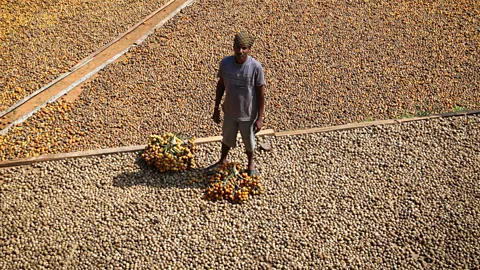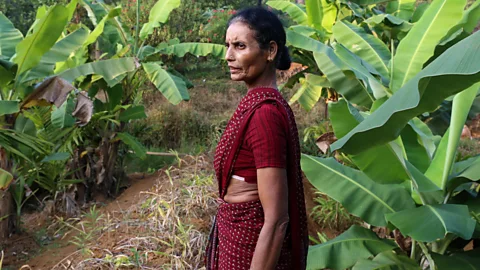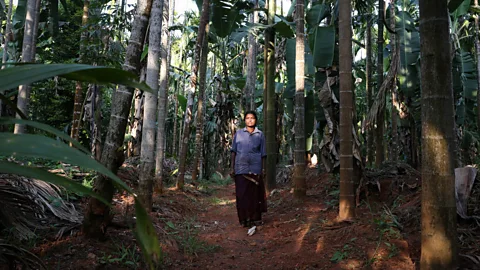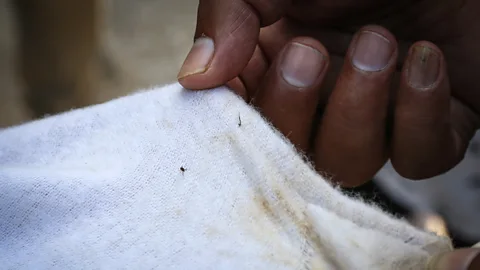Why areca nut plantations are driving 'monkey fever'
 Catherine Davison
Catherine DavisonA tick-borne infection often spread in areca nut plantations in India is among several on the rise around the world. Can we get better at tackling these outbreaks?
When Gayatri thinks of her husband, the first thing that she remembers is his voice. "He used to never stop talking," she recalls fondly.
One evening in early 2019, Suresh had arrived home from the areca palm nut plantation where he worked complaining of a headache, and had quietly taken himself off to bed. His mumbled goodnight was among the last thing Gayatri would hear him say. Four days later, his health rapidly deteriorating, he had a stroke which left him permanently unable to talk.
The mysterious illness which had struck Suresh down was spreading like wildfire that winter through Aralagodu, a tiny village in the middle of a forest in Karnataka, a state in southern India. By the end of that winter, 14 people had died – 0.5% of its inhabitants. A year after his stroke, Suresh also succumbed to the disease, leaving behind two young children.
"I would have paid any price to keep him alive," Gayatri tells me, as we sit watching the couple's nine-year-old son play cricket outside the family home. "I did everything – I made sure he took his medicine at the correct time. But I wasn't able to save him."
Kyasanur forest disease (KFD) – named after the forest in which it originated – is a tick-borne haemorrhagic disease with a fatality rate of around 5%. Also known as "monkey fever", it was first discovered in 1957 after an outbreak in Shivamogga, the district of Karnataka in which Aralagodu is also situated.
In the following decades, recurring outbreaks remained largely confined to the area. But in recent years, the disease has begun to spread, with cases popping up for the first time in 2013 in the neighbouring states of Tamil Nadu and Kerala, followed by Goa in 2015 and Maharashtra in 2016.
Still, the disease barely registers on global health watchlists; outbreaks largely occur in rural areas bordering forest land and affect a tiny percentage of India's population. But the spread of the disease is indicative of a much larger, more worrying trend, as highlighted most recently by the Covid-19 pandemic: the increasing likelihood of zoonotic disease spilling over into human populations.
 Catherine Davison
Catherine DavisonDeforestation, changing land use and climate change is putting humans into increasing contact with new viruses. Zoonotic diseases – diseases which can be transmitted between humans and animal species – comprise the majority of new and existing diseases which affect human populations.
Most researchers believe that KFD was endemic for centuries in the forests of the Western Ghats in India, circulating silently among primate, bird and rodent populations, and the ticks they carry. But as forest land was fragmented by human activity, and changing rainfall patterns affected tick development cycles, the delicate balance of disease cycles was disrupted – triggering new outbreaks.
"New hotspots are probably where the forest landscape has changed, or people's use of the forest has changed, say in the preceding five to 10 years, and that's what's driving the spillover," says Bethan Purse, an ecologist and vector-borne disease specialist at the UK Centre for Ecology & Hydrology (UKCEH), who is currently leading an interdisciplinary research project to better understand the dynamics of KFD.
The pursuit of areca nuts
Consumption of addictive areca nuts, also known as betel nuts, is itself a major health concern, with risk factors for many oral and oesophageal cancers. It is consumed by hundreds of thousands of people across the Asia-Pacific region as well as in the US, making it one of the most widely used psychoactive substances worldwide alongside tobacco, alcohol and caffeine.
However, unlike tobacco, no global policy exists for the control of its use, with researchers labelling it a "neglected global public health emergency".
The Western Ghats, a mountain range in southern India, is home to huge stretches of largely undisturbed forest. But the area is undergoing deforestation at unprecedented rates, in part due to a boom in commercial agroforestry.
Deforestation in the Shivamogga region has been driven by growing demand for areca nuts, which come from the areca palm tree. Areca nuts are a popular stimulant drug when ground up and chewed.
Areca palm plantations like the one where Suresh worked are hotspots for KFD, because they break up dense, undisturbed forest, creating "transition zones" where forests – and the diseases which lurk within – meet plantations and human habitats.
"What the degradation does is really bring people into contact with the ticks," explains Purse.
The next pandemic
With deforestation accelerating across the globe, experts fear that the increased contact between human, animal and vector populations risks triggering the next pandemic.
One study published in the journal Nature in 2020 found that habitat disturbance led to lower biodiversity and an increase in animal vectors – such as rodents and bats – known to harbour diseases shared by humans. "Global changes in the mode and the intensity of land use are creating expanding hazardous interfaces between people, livestock and wildlife reservoirs of zoonotic disease," the study authors warn.
 Catherine Davison
Catherine DavisonClimate change also plays a role in increasing the risk of zoonotic disease spill-overs, causing shifts in rainfall patterns and affecting biodiversity. Another study published in Nature last year found that climate change would lead to an increase in cross-species transmission of viral diseases, with a predicted 4000 new spillover events in the next half century.
When it comes to KFD, says Purse, climate change will speed up the development cycles and mortality rates of the ticks, leading to a more rapid turnover of ticks and increasing the amount of time they need to spend feeding on a host. The distribution of the ticks’ hosts, and their overlap with people, will also be affected, she adds – meaning that humans are increasingly likely to come into contact with infected ticks, and in an increasing number of places.
The spread of Lyme disease
Lyme disease is the most common kind of tick-borne infection globally, found across Asia, Europe, Canada as well as the US, where it is the most common vector-borne disease. It is caused by Borrelia burgdorferi bacteria which can be spread to humans when they are bitten by infected ticks. It can cause fever, fatigue, joint pain and skin rash, as well as more serious complications.
A 2022 study in the British Medical Journal (BMJ) estimated that an astonishing 14.5% of the global population has had, or has, Lyme disease. Research has found climate change is increasing the range and activity of ticks carrying Lyme disease.
Prema Jain, a 52-year-old grandmother in Aralagodu, contracted KFD during the 2019 outbreak after finding a dead monkey in the family’s banana plantation. Although she reported the animal to the forest department, it was too late: the ticks it had been carrying had already crawled off into the surrounding areas, eventually infecting her entire family.
Jain says that living in the forest, it is not unusual to find dead animals, but that the threat of KFD is new. "We have always had ticks, but only recently disease," she says.
Globally, tick-borne diseases are an increasing menace, with research showing that they are on the rise in countries such as the US. And yet the dangers are often little known to the public, especially for tick-borne diseases other than Lyme disease. There are also fewer surveillance systems in place for tick-borne diseases than exist for similar diseases spread by other vectors, such as mosquitoes.
Purse and her team hope to change that. Monkey Fever Risk project is an Indo-UK partnership between UKCEH, the Karnataka state government, and various interdisciplinary research institutes in India, which aims to map historical patterns of KFD in order to determine the main risk factors for new outbreaks.
By looking at various environmental factors, such as the level of forest cover and rainfall patterns, and social factors like livelihood activities and proximity to healthcare centres, the team make models of the main drivers of the disease.
 Catherine Davison
Catherine DavisonThis data is fed into an interactive tool to predict new areas at risk of disease emergence, allowing public health officials, the forest department and animal husbandry experts to proactively tackle outbreaks.
"When plotted for the entire country, it shows that yes, there are other places which have a favourable condition [for disease emergence]," says Darshan Narayan, a research associate on the KFD project specialising in epidemiological modelling. He believes that as surveillance increases in these areas, more cases will be discovered.
You might also like:
The collaboration has provided vital lessons on the importance of predictive disease modelling for diseases where the drivers of emergence are less well understood. The Indian government now aims to replicate the project for other diseases such as scrub typhus, which is spread by mites, and leptospirosis, spread by infected animals. "Right now in India, I don't think there are many people who are working on these kind of predictive maps," says Narayan. Globally, predictive diseases modelling is often used for high-focus diseases like Covid-19, but many neglected diseases which lack funding can fall under the radar of such tools.
Bringing together experts in human, animal and environmental health is known as One Health, a framework recommended by the WHO as the best approach for tackling zoonotic diseases. The Monkey Fever Risk project is a model of how One Health collaboration can happen, says Purse.
The modelling tool has also proven to be an important visual aid for local healthcare workers, says Narayan.
"For visualisation, this tool is wonderful," he says. "[If] I show them this, they understand the dynamics of the disease very fast."
 Catherine Davison
Catherine DavisonThere are lessons to be learnt for the UK team, too – especially when it comes to tick-borne diseases, says Purse.
"Quite often we don't have good vaccines against tick-borne diseases, so it's really important to look across the different tick-borne diseases globally and understand what the risk factors are leading to spillovers," she says. "We’re actually extending these approaches now into the UK, looking at Lyme disease and tick-borne encephalitis virus."
A KFD vaccine previously in use recently had its license revoked due to low efficacy, so understanding the risk factors for the disease is even more important. One element of the Monkey Fever Risk project has been to increase awareness of the dangers posed by ticks and help healthcare workers to push for behavioural changes.
However, lack of economic opportunity means that locals often have little choice but to continue entering plantations and forests for work.
"I only know how to do this sort of work – I don't have any other skills," says Govindha, a 56-year-old plantation worker who fell into a week-long coma after contracting the disease. His wife, Laxmi, was also hospitalised. "I thought we were both going to die," she remembers. "I told my son to give our cows to someone else." Despite their ordeal, the couple both returned to work in the plantation.
After Suresh died, Gayatri, now the family's sole breadwinner, also felt that she had no choice but to return to her job collecting areca nuts inside the plantation. Still, she believes that better awareness of the disease is important; if she had taken Suresh to the hospital immediately, she says, he might still be alive.
"I hadn't heard of KFD before," she says. "If I had known, I might have been able to act more quickly."
--
